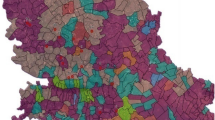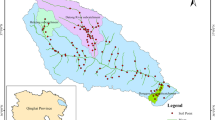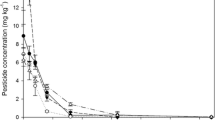Abstract
Turkey is the sixth largest producer of cotton in the world. Two of the most commonly applied pesticides used in cotton production are trifluralin and endosulfan. Although both are very effective at controlling pests, their persistence in the environment poses risks to human health and the environment. Four loam soils and one silty-loam soil were studied to evaluate the persistence of trifluralin and endosulfan in relation to soil characteristics. Degradation with trifluralin reached as high as 70% of the applied doses. Soils with the highest organic matter content had the lowest degradation rate, indicating a tighter sorption of trifluralin. Endosulfan degradation was a function of soil type and the specific isomer, with β-endosulfan depicting the highest degradation.
Similar content being viewed by others
References
Arshad, M., Hussain, S., & Saleem, M. (2008). Optimization of environmental parameters for the biodegradation of alpha and beta endosulfan in soil slurries by Pseudomonas aeruginosa. Journal of Applied Microbiology, 104, 364–370.
Awasthi, N., Ahuja, R., & Kumar, A. (2000). Factors influencing the degradation of soil-applied endosulfan isomers. Soil Biology & Biochemistry, 32, 1697–1705. doi:10.1016/S0038-0717(00)00087-0.
Boivin, A., Cherrier, R., & Schiavon, M. (2005). A comparison of five pesticides adsorption and desorption processes in thirteen contrasting field soils. Chemosphere, 61, 668–676. doi:10.1016/j.chemosphere.2005.03.024.
Bhalerao, T., & Puranik, P. R. (2007). Biodegradation of organochlorine pesticide, endosulfan, by a fungal isolate, Aspergillus niger. International Biodeterioration & Biodegradation, 59, 315–321. doi:10.1016/j.ibiod.2006.09.002.
Braunschweiler, H. (1992). The fate of some pesticides in Finnish cultivated soils. Agricultural Science in Finland, 1, 37–55.
Cooke, C. M., Shaw, G., & Collins, C. D. (2004). Determination f solid-liquid partition coefficients (Kd) for the herbicides isoproturon and trifluralin in five UK agricultural soils. Environmental Pollution, 132, 541–552. doi:10.1016/j.envpol.2004.04.027.
Critter, S. A. M., Freitas, S. S., & Airoldi, C. (2004). Microcalorimetric measurements of the metabolic activity by bacteria and fungi in some Brazilian soils amended with different organic matter. Thermochimica Acta, 417, 275–281. doi:10.1016/j.tca.2003.09.033.
Deger, A. B., Gremm, T. J., Frimmel, F. H., & Mendez, L. (2003). Optimization and application of SPME for the gas chromatographic determination of endosulfan and its major metabolites in the ng/L range in aqueous soluitons. Analytical and Bioanalytical Chemistry, 376, 61–68.
Fennell, B. J., Naughton, J. A., Dempsey, E., & Bell, A. (2006). Cellular and molecular actions of dinitroaniline and phosphorothioamidate herbicides on Plasmodium falciparum: Tubulin as a specific antimalarial target. Molecular and Biochemical Parasitology, 145, 226–238. doi:10.1016/j.molbiopara.2005.08.020.
Fernandes, T. C. C., Mazzeo, D. E. C., & Marin-Morales, M. A. (2007). Mechanism of micronuclei formation in polyploidizated cells of Allium cepa exposed to trifluralin herbicide. Pesticide Biochemistry and Physiology, 88, 252–259. doi:10.1016/j.pestbp.2006.12.003.
Gebel, T., Kevekordes, S., Pav, K., Edenharder, R., & Dunkelberg, H. (1997). In vivo genotoxicity of selected herbicides in the mouse bone-marrow micronucleus test. Archives of Toxicology, 71, 193–197. doi:10.1007/s002040050375.
Ghardiri, H., & Rose, C. W. (2001). Degradation of endosulfan in a clay soil from cotton farms of western Queensland. Journal of Environmental Management, 62, 155–169. doi:10.1006/jema.2001.0428.
Hengpraprom, S., Lee, C. M., & Coates, J. T. (2006). Sorption of humic acids and α-endosulfan by clay minerals. Environmental Toxicology and Chemistry, 25, 11–17. doi:10.1897/05-119R.1.
Hiller, E., Krascsenits, Z., & Cernansky, S. (2008). Sorption of acetochlor, atrazine, 2,4-D, chorotolluene and trifluralin in six soils from Slovakia. Bulletin of Environmental Contamination and Toxicology, 80, 412–416. doi:10.1007/s00128-008-9430-9.
Hussain, S., Arshad, M., Saleem, M., & Khalid, A. (2007). Biodegradatio of α and β-endosulfan by soil bacteria. Biodegradation, 18, 731–740. doi:10.1007/s10532-007-9102-1.
Ismai, B. S., Enoma, A., Cheah, U., Lum, K. Y., & Malik, Z. (2002). Adsorption, desorption, and mobility of two insecticides in Malaysian agricultural soil. Journal of Environmental Science and Health. Part. B, Pesticides, Food Contaminants, and Agricultural Wastes, 37, 355–364. doi:10.1081/PFC-120004476.
Jensen, P. K., & Spliid, N. H. (2003). Deposition of spray liquid on the soil below cereal crops after applications during the growing season. Weed Research, 43, 362–370. doi:10.1046/j.1365-3180.2003.00354.x.
Johnstone, P. K., Jolley, A. V., Code, G. R., Moerkerk, M. R., & Corbett, A. (1998). Degradation of trifluralin in three Victorian soils—Long-term field trials. Australian Journal of Experimental Agriculture, 38, 363–374. doi:10.1071/EA97076.
Jolley, A. V., & Johnstone, P. K. (1994). Degradation of trifluralin in 3 Victorian soils under field and laboratory conditions. Australian Journal of Experimental Agriculture, 34, 57–65. doi:10.1071/EA9940057.
Konen, S., & Cavas, T. (2008). Genotoxicity testing of the herbicide trifluralin and its commercial formulation treflan using the piscine micronucleus test. Environmental and Molecular Mutagenesis, 49, 434–438. doi:10.1002/em.20401.
Kumar, M., & Philip, L. (2006). Adsorption and desorption characteristics of hydrophobic pesticide endosulfan in four Indian soils. Chemosphere, 62, 1064–1077. doi:10.1016/j.chemosphere.2005.05.009.
Kumar, M., Lakshmi, V., & Khana, S. (2008). Biodegradatin and bioremediation of endosulfan contaminated soil. Bioresource Technology, 99, 3116–3122. doi:10.1016/j.biortech.2007.05.057.
Kyriakopoulos, G., Doulia, D., & Anagnostopoulos, E. (2005). Adsorption of pesticides on porous polymeric adsorbents. Chemical Engineering Science, 60, 1177–1186. doi:10.1016/j.ces.2004.09.080.
Mamy, L., & Barriuso, E. (2007). Desorption and time-dependent sorption of herbicides in soils. European Journal of Soil Science, 58, 174–187. doi:10.1111/j.1365-2389.2006.00822.x.
Oldal, B., Maloschik, E., Uzinger, N., Anton, A., & Szekacs, A. (2006). Pesticide residues in Hungarian soils. Geoderma, 135, 163–178. doi:10.1016/j.geoderma.2005.11.011.
Pu, X. C., & Cutright, T. J. (2007). Degradation of pentachlorophenol by pure and mixed cultures in two different soils. Environmental Science and Pollution Research, 14, 244–250. doi:10.1065/espr2006.07.321.
Saghir, S., Charles, G. D., Bartels, M. J., Kan, L., Dryzga, M. D., Brzak, A., et al. (2008). Mechanism of trifluralin-induced thyroid tumors in rats. Toxicology Letters, 180, 38–45. doi:10.1016/j.toxlet.2008.05.019.
Schweizer, A., Turgut, C., & Hurle, K. (2000). Influence of temperature and relative humidity on the volatilisation of pesticides. Zeitschrift Fur Pflanzenkrankheiten Und Pflanzenschutz-Journal of Plant Diseases and Protection, 17, 791–798.
Singh, R. P., & Kumar, R. (2004). Endosulfan adsorption on soils in soil–water suspensions containing cationic, non-ionic and anionic surfactants. Journal of the Indian Society of Soil Science, 52, 439–447.
Tiryaki, O., Yucel, U., & Sezen, G. (2004). Biodegradation of trifluralin in Harran soil. Journal of Environmental Science and Health. Part. B, Pesticides, Food Contaminants, and Agricultural Wastes, 39, 747–756. doi:10.1081/PFC-200030847.
Tomlin, C. (2006). The pesticide manual (14th edn). London: British Crop Protection Council.
Trapp, S. (2004). Plant uptake and transport models for neutral and ionic chemicals. Environmental Science and Pollution Research, 11, 33–39. doi:10.1065/espr2003.08.169.
Turgut, C. (2003). The contamination with organochlorine pesticides and heavy metals in surface water in Kucuk Menderes River in Turkey, 2000–2002. Environment International, 29, 29–32. doi:10.1016/S0160-4120(02)00127-7.
Turgut, C. (2005). Uptake and modeling of pesticides by roots and shoots of parrotfeather (Myriophyllum aquaticum). Environmental Science and Pollution Research, 12, 342–346. doi:10.1065/espr2005.05.256.
Turgut, C. (2007). The impact of pesticides toward parrotfeather when applied at the predicted environmental concentration. Chemosphere, 66, 469–473. doi:10.1016/j.chemosphere.2006.05.073.
Turgut, C., & Fomin, A. (2002). Residues of selected pesticides in the Kucuk Menderes river in Turkey. Zeitschrift Fur Pflanzenkrankheiten Und Pflanzenschutz-Journal of Plant Diseases and Protection, 18, 1053–1057.
Uludag, A., Uremis, I., Ulger, A. C., Cakir, B., & Aksoy, E. (2006). The use of maize as replacement crop in trifluralin treated fields in Turkey. Crop Protection (Guildford, Surrey), 25, 275–280. doi:10.1016/j.cropro.2005.05.005.
Uludag, A., Nemli, Y., Tal, A., & Rubin, B. (2007). Fenoxaprop resistance in sterile wild oat (Avena sterilis) in wheat fields in Turkey. Crop Protection (Guildford, Surrey), 26, 930–935. doi:10.1016/j.cropro.2006.08.012.
Unlu, L., & Bilgic, A. (2004). The effects of the infestation ration of spiny bollworm and pink bollworm on cotton yield grow in semi-arid region of Turkey. Journal of Applied Entomology, 128, 652–657.
Winkaler, E. U., Santos, T. R. M., Machado-Neto, J. G., & Martinez, C. B. R. (2007). Acute lethal and sublethal effects of neem leaf extract on the neotropical freshwater fish Prochilodus lineatus. Comparative Biochemistry and Physiology, 145(Part C), 236–244.
Jayashree, R., & Vasudevan, N. (2007). Effect of Tween 80 added to the soil on the degradation of endosulfan by Pseudomonas aeruginosa. International Journal of Environmental Science, 4, 203–210.
Yilmaz, I., Akcaoz, H., & Ozkan, B. (2005). An analysis of energy use and input costs for cotton production in Turkey. Renewable Energy, 30, 145–155. doi:10.1016/j.renene.2004.06.001.
Ying, G. G., & Williams, B. D. (2000). Mobility and persistence of four herbicides in soil of a South Australian vineyard. Pest Management Science, 56, 277–283. doi:10.1002/(SICI)1526-4998(200003)56:3<277: :AID-PS132>3.0.CO;2-2.
Zaidenberg, A., Marra, C., Luong, T., Gomez, P., Milani, L., Villagra, S., et al. (2007). Trifluralin toxicity in a chagas disease mouse model. Basic Clinical Pharmacology, 101, 90–95. doi:10.1111/j.1742-7843.2007.00079.x.
Author information
Authors and Affiliations
Corresponding author
Rights and permissions
About this article
Cite this article
Turgut, C., Erdogan, O., Ates, D. et al. Persistence and behavior of pesticides in cotton production in Turkish soils. Environ Monit Assess 162, 201–208 (2010). https://doi.org/10.1007/s10661-009-0788-x
Received:
Accepted:
Published:
Issue Date:
DOI: https://doi.org/10.1007/s10661-009-0788-x




